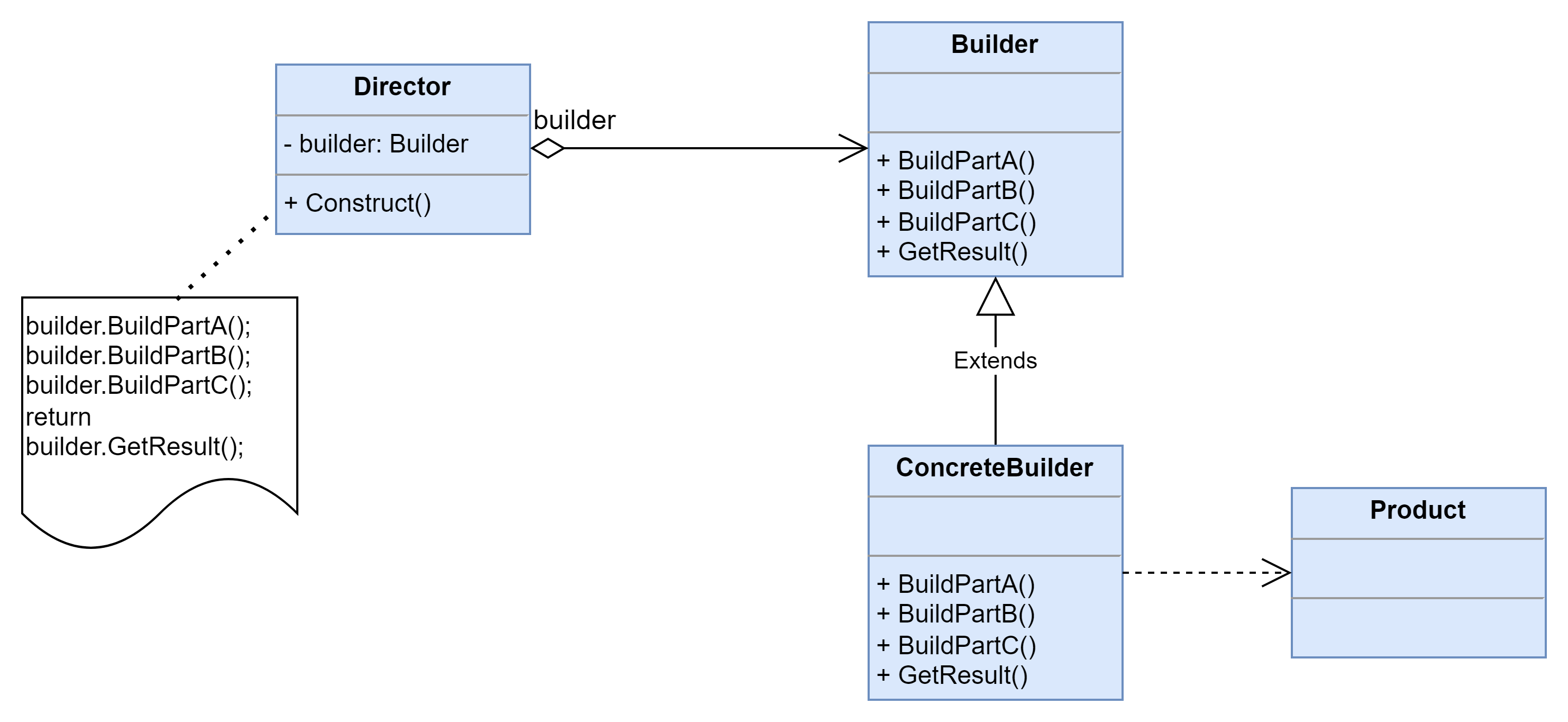建造者模式 (Builder Pattern)
将一个复杂对象的构建与它的表示分离,使得同样的构建过程可以创建不同的表示。
结构图
- Builder(抽象建造者):它为创建一个产品Product对象的各个部件指定抽象接口,在该接口中一般声明两类方法,一类方法是BuildPartX(),它们用于创建复杂对象的各个部件;另一类方法是GetResult(),它们用于返回复杂对象。Builder既可以是抽象类,也可以是接口。
- ConcreteBuilder(具体建造者):它实现了Builder接口,实现各个部件的具体构造和装配方法,定义并明确它所创建的复杂对象,也可以提供一个方法返回创建好的复杂产品对象。
- Product(产品角色):它是被构建的复杂对象,包含多个组成部件,具体建造者创建该产品的内部表示并定义它的装配过程。
- Director(指挥者):指挥者又称为导演类,它负责安排复杂对象的建造次序,指挥者与抽象建造者之间存在关联关系,可以在其Construct()建造方法中调用建造者对象的部件构造与装配方法,完成复杂对象的建造。客户端一般只需要与指挥者进行交互,在客户端确定具体建造者的类型,并实例化具体建造者对象(也可以通过配置文件和反射机制),然后通过指挥者类的构造函数或者Setter方法将该对象传入指挥者类中。
示例
using System;
using System.Collections.Generic;
namespace DesignPatterns.Builder
{
// The Builder interface specifies methods for creating the different parts
// of the Product objects.
public interface IBuilder
{
void BuildPartA();
void BuildPartB();
void BuildPartC();
}
// The Concrete Builder classes follow the Builder interface and provide
// specific implementations of the building steps. Your program may have
// several variations of Builders, implemented differently.
public class ConcreteBuilder : IBuilder
{
private Product _product = new Product();
// A fresh builder instance should contain a blank product object, which
// is used in further assembly.
public ConcreteBuilder()
{
this.Reset();
}
public void Reset()
{
this._product = new Product();
}
// All production steps work with the same product instance.
public void BuildPartA()
{
this._product.Add("PartA1");
}
public void BuildPartB()
{
this._product.Add("PartB1");
}
public void BuildPartC()
{
this._product.Add("PartC1");
}
// Concrete Builders are supposed to provide their own methods for
// retrieving results. That's because various types of builders may
// create entirely different products that don't follow the same
// interface. Therefore, such methods cannot be declared in the base
// Builder interface (at least in a statically typed programming
// language).
//
// Usually, after returning the end result to the client, a builder
// instance is expected to be ready to start producing another product.
// That's why it's a usual practice to call the reset method at the end
// of the `GetProduct` method body. However, this behavior is not
// mandatory, and you can make your builders wait for an explicit reset
// call from the client code before disposing of the previous result.
public Product GetProduct()
{
Product result = this._product;
this.Reset();
return result;
}
}
// It makes sense to use the Builder pattern only when your products are
// quite complex and require extensive configuration.
//
// Unlike in other creational patterns, different concrete builders can
// produce unrelated products. In other words, results of various builders
// may not always follow the same interface.
public class Product
{
private List<object> _parts = new List<object>();
public void Add(string part)
{
this._parts.Add(part);
}
public string ListParts()
{
string str = string.Empty;
for (int i = 0; i < this._parts.Count; i++)
{
str += this._parts[i] + ", ";
}
str = str.Remove(str.Length - 2); // removing last ",c"
return "Product parts: " + str + "\n";
}
}
// The Director is only responsible for executing the building steps in a
// particular sequence. It is helpful when producing products according to a
// specific order or configuration. Strictly speaking, the Director class is
// optional, since the client can control builders directly.
public class Director
{
private IBuilder _builder;
public IBuilder Builder
{
set { _builder = value; }
}
// The Director can construct several product variations using the same
// building steps.
public void BuildMinimalViableProduct()
{
this._builder.BuildPartA();
}
public void BuildFullFeaturedProduct()
{
this._builder.BuildPartA();
this._builder.BuildPartB();
this._builder.BuildPartC();
}
}
class Program
{
static void Main(string[] args)
{
// The client code creates a builder object, passes it to the
// director and then initiates the construction process. The end
// result is retrieved from the builder object.
var director = new Director();
var builder = new ConcreteBuilder();
director.Builder = builder;
Console.WriteLine("Standard basic product:");
director.BuildMinimalViableProduct();
Console.WriteLine(builder.GetProduct().ListParts());
Console.WriteLine("Standard full featured product:");
director.BuildFullFeaturedProduct();
Console.WriteLine(builder.GetProduct().ListParts());
// Remember, the Builder pattern can be used without a Director
// class.
Console.WriteLine("Custom product:");
builder.BuildPartA();
builder.BuildPartC();
Console.Write(builder.GetProduct().ListParts());
}
}
}运行结果
1
2
3
4
5
6
7
8
Standard basic product:
Product parts: PartA1
Standard full featured product:
Product parts: PartA1, PartB1, PartC1
Custom product:
Product parts: PartA1, PartC1
总结
建造者模式的核心在于如何一步步构建一个包含多个组成部件的完整对象,使用相同的构建过程构建不同的产品,在软件开发中,如果我们需要创建复杂对象并希望系统具备很好的灵活性和可扩展性可以考虑使用建造者模式。
优点
- 在建造者模式中,客户端不必知道产品内部组成的细节,将产品本身与产品的创建过程解耦,使得相同的创建过程可以创建不同的产品对象。
- 每一个具体建造者都相对独立,而与其他的具体建造者无关,因此可以很方便地替换具体建造者或增加新的具体建造者,用户使用不同的具体建造者即可得到不同的产品对象。由于指挥者类针对抽象建造者编程,增加新的具体建造者无须修改原有类库的代码,系统扩展方便,符合“开闭原则”
- 可以更加精细地控制产品的创建过程。将复杂产品的创建步骤分解在不同的方法中,使得创建过程更加清晰,也更方便使用程序来控制创建过程。
缺点
- 建造者模式所创建的产品一般具有较多的共同点,其组成部分相似,如果产品之间的差异性很大,例如很多组成部分都不相同,不适合使用建造者模式,因此其使用范围受到一定的限制。
- 如果产品的内部变化复杂,可能会导致需要定义很多具体建造者类来实现这种变化,导致系统变得很庞大,增加系统的理解难度和运行成本。
适用场景
- 需要生成的产品对象有复杂的内部结构,这些产品对象通常包含多个成员属性。
- 需要生成的产品对象的属性相互依赖,需要指定其生成顺序。
- 对象的创建过程独立于创建该对象的类。在建造者模式中通过引入了指挥者类,将创建过程封装在指挥者类中,而不在建造者类和客户类中。
- 隔离复杂对象的创建和使用,并使得相同的创建过程可以创建不同的产品。
This post is licensed under CC BY 4.0 by the author.
